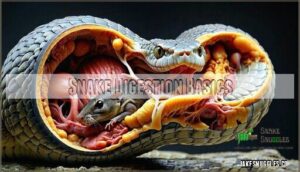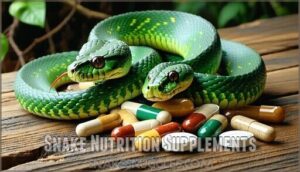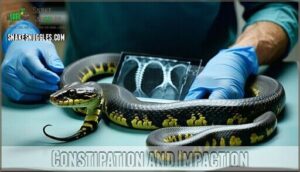This site is supported by our readers. We may earn a commission, at no cost to you, if you purchase through links.
 The best snake food for digestion is properly thawed, appropriately sized frozen rodents, like mice or rats.
The best snake food for digestion is properly thawed, appropriately sized frozen rodents, like mice or rats.
They’re safe, easy to digest, and packed with the nutrients your snake needs.
Make sure the prey isn’t too big—a general rule is no wider than your snake’s middle.
Feeding live prey can stress your snake or cause injuries, so frozen is usually the better choice.
Also, keep them hydrated and make certain their habitat has the right temperature and humidity.
A warm basking spot helps them digest efficiently, like their own little reptile oven.
Want to avoid common digestive issues?
It’s all about balance and providing the right conditions, including a suitable environment with the correct temperature and humidity.
Table Of Contents
- Key Takeaways
- Snake Digestion Basics
- Nutritious Snake Food
- Prey Selection Guidelines
- Environmental Digestive Factors
- Snake Nutrition Supplements
- Common Digestive Issues
- Frequently Asked Questions (FAQs)
- What is the most nutritious food for snakes?
- How many days does it take for a snake to digest food?
- What should you not feed a snake?
- Do snakes have a good digestive system?
- What are good snacks for a renal diet?
- How does a snake digest food?
- What intestines do snakes eat?
- What is the best food for snakes?
- Do snakes fully digest food?
- What can I feed my snake instead of mice?
- Conclusion
Key Takeaways
- Make sure to feed thawed, appropriately sized frozen rodents like mice or rats—no wider than your snake’s middle—for easy digestion and safety.
- Keep the enclosure warm and humid, as proper temperatures and hydration are essential for smooth digestion.
- Avoid feeding live prey to prevent stress or injury; frozen-thawed options are safer and more reliable.
- Stick to a consistent feeding schedule and monitor prey size to prevent regurgitation, obesity, or digestive issues.
Snake Digestion Basics
Understanding how your snake digests food helps you choose the right meals for its health.
Snakes rely on unique adaptations, like swallowing whole prey and using enzymes or venom, to efficiently process their meals, which is a complete concept to consider for their well-being.
Swallowing whole prey and utilizing venom or enzymes, snakes master digestion with remarkable efficiency, ensuring optimal health and well-being.
Unique Feeding Mechanisms
Snakes have fascinating feeding mechanisms that enable them to swallow prey whole.
Their jaw flexibility increases gape size, allowing them to consume animals larger than their heads.
Here’s how they tackle meals:
- Constriction Methods: Tighten around prey for suffocation.
- Venom Delivery: Immobilize prey quickly.
- Swallowing Whole: No chewing involved!
- Snake Digestion Perfected: Adapted to process unbroken prey efficiently.
Digestive Enzymes and Venom
Ever wondered how venom doubles as a digestive superpower?
Venom isn’t just for hunting; it’s a digestive powerhouse, breaking down prey from the inside out for effortless absorption.
Venom aids digestion by breaking down prey with enzymes like phospholipases. This boosts digestion efficiency and nutrient absorption. The enzymes don’t just immobilize prey—they set up the perfect meal inside out.
Venom Enzyme Function
Factors Affecting Digestion Speed
A well-rounded snake digestion diet depends on factors like prey type, snake size, and meal size.
Warm temperatures and proper hydration levels improve digestion, while a balanced gut microbiome boosts reptile digestive health.
Choose snake food types aligning with your snake feeding guide to avoid issues.
Proper temperatures are essential for healthy digestion.
Adjust your pet’s snake digestion diet to optimize digestion speed and overall health, ensuring a balanced gut microbiome and proper care for healthy digestion.
Nutritious Snake Food
Feeding your snake the right food is essential for its digestion and overall health.
By choosing nutritious options like frozen prey and ensuring proper prey size, you can keep your snake healthy and satisfied.
Frozen Vs. Live Prey
Choosing between live and frozen prey impacts your snake’s health and safety.
Live prey risks include injuries and parasite exposure, while frozen snake food offers convenience and consistent Frozen Nutrition.
Follow this snake feeding guide:
- Always thaw frozen food safely.
- Use tongs for handling frozen prey.
- Avoid feeding cold prey.
- Store frozen food properly.
- Prevent ethical concerns by skipping live snake food, which can ensure safe and healthy feeding practices.
Prey Size and Feeding Frequency
When deciding on snake food size, choose prey matching your snake’s widest body part.
Hatchling feeding might occur twice weekly, while adult schedules usually require feeding every 7–14 days.
Obesity risks increase with oversized meals or frequent snacks.
Proper meal spacing supports digestion and prevents regurgitation.
Stick to a consistent snake feeding schedule to meet dietary needs and improve digestion and prevent issues like regurgitation.
Nutritional Balance Considerations
Balancing a snake’s diet isn’t tricky if you know the basics.
It’s all about providing the right mix for snake nutrition and digestive health.
Focus on these:
- Protein Sources: Key for growth and energy. Think rodents or birds.
- Calcium Ratios: Prevents weak bones—don’t skip it.
- Hydration Importance: Fresh water daily keeps your reptile’s nutrition on point.
A balanced diet should also consider prey size selection to prevent overfeeding.
Prey Selection Guidelines
Choosing the right prey is key to keeping your snake healthy and ensuring smooth digestion. Consider your snake’s species, size, and natural diet to match their unique needs.
Constrictors and Large Prey
Constrictors thrive on whole prey like mice, rats, or even rabbits for larger species.
Verify prey size matches the snake’s widest point for safe swallowing and proper digestion time.
Feeding safety is vital—always use ethically sourced, frozen-thawed prey.
Whole prey meets nutritional needs, supporting your snake’s health, and provides a satisfying meal for your constrictor’s instincts!
Venomous Snakes and Small Mammals
Venomous snakes rely on their venom yield to subdue small mammals, aiding digestion by breaking down prey tissues.
Prey resistance is rare, but envenomation symptoms guarantee swift effects.
Feeding appropriately-sized snake food supports their dietary needs and overall health. To improve snake digestion, avoid overly large prey and guarantee a calm environment to reflect their natural behaviors, enhancing snake health.
Snakes’ diets are diverse, and they consume various types of prey, which is crucial for their overall health and natural behaviors, and also involves diverse diets.
Arboreal Snakes and Birds
Arboreal snakes love birds as part of their diet. Understanding their needs guarantees healthy digestion and prevents issues like avian diseases.
Consider these tips:
- Match bird size to the snake’s width for safe swallowing.
- Feathers aid digestion but avoid tough, unmanageable prey.
- Monitor nest raiding to guarantee natural hunting strategies enrich reptile nutrition and maintain a solid snake food routine, ensuring healthy digestion.
Environmental Digestive Factors
Your snake’s environment plays a big role in how well it digests its food.
By managing temperature, humidity, and stress, you can keep their digestive system running smoothly and avoid common problems.
Temperature Gradient and Basking Spots
Snakes rely on heat for digestion and activity. A well-set temperature gradient allows thermoregulation behaviors, like basking or cooling down, boosting digestion efficiency.
Place heat sources at one end to create ideal temperatures. A proper setup requires reliable heat lamps.
Check this reptile care guide for specifics:
| Snake Type | Basking Temp | Cool End Temp | Gradient Importance | Heat Sources |
|---|---|---|---|---|
| Ball Python | 88–92°F | 75–80°F | Essential | Heat lamp, mat |
| Corn Snake | 85–90°F | 72–75°F | Necessary | Heat lamp, pad |
| Boa Constrictor | 90–95°F | 77–80°F | Critical | Ceramic heater |
| King Snake | 85–89°F | 70–75°F | Recommended | Under-tank warmer |
| Green Tree Python | 86–88°F | 78–80°F | Important | Heat panel, bulb |
These simple snake health tips keep digestion smooth and your pet happy!
Humidity Levels and Hydration
Proper humidity levels support shedding and digestion.
Monitor humidity with a reliable gauge, especially in drier climates.
Clean the water bowl daily; snakes often soak, which helps hydration and overall health.
Signs like wrinkled skin reveal hydration needs.
Misting benefits hydration and humidity control.
Balanced humidity promotes better digestion—critical when feeding nutritious snake food like frozen prey.
Consider using a digital reptile hygrometer for accurate readings.
Keep it steady and ensure proper humidity levels are maintained for the snake’s health, and remember that misting is beneficial for hydration and also supports better digestion.
Stress Reduction Techniques
A calm snake is a happy snake.
Stress affects digestion, so focus on creating a peaceful environment.
Try these:
- Provide hiding spots to mimic natural habitats.
- Use gentle handling techniques based on snake behavior.
- Stick to a consistent feeding schedule.
- Keep environmental temperature stable in their enclosure design.
- Offer enrichment activities like climbing branches for mental stimulation.
Snakes require secure hiding places to reduce stress, and creating a stable and natural environment is key.
Snake Nutrition Supplements
If you want to give your snake an extra nutritional boost, supplements like calcium, probiotics, and multivitamins can help.
These additions support bone health, digestion, and overall well-being, making them a valuable part of your care routine.
Calcium and Vitamin D3 for Bone Health
Strong bones keep your snake slithering smoothly.
Calcium sources like whole-prey meals support bone density, while vitamin D3 helps with D3 synthesis from UV light or supplements.
Without enough, your snake risks metabolic bone disease or skeletal abnormalities.
Stick to proper supplement dosage—too much causes bone diseases.
Pair balanced nutrition with gentle basking spots for healthy, happy scales.
Probiotics for Digestive Balance
Improving your snake’s gut health starts with probiotics. These supplements support digestion, help balance gut flora, and reduce digestive issues like constipation.
Look for species-specific probiotic strains and follow dosage guidelines for the best results. Timing is key—mix it with food or water weekly.
- Boosts intestinal health for better digestion.
- Reduces stress-related gut problems.
- Enhances nutrient absorption effectively, which is crucial for maintaining overall health and preventing issues like constipation.
Multivitamins and Minerals for Nutrition
Just like probiotics help the gut, multivitamin supplements fill gaps in your snake’s diet.
Balanced ratios of snake vitamins and minerals support growth and prevent nutrient deficiency.
Avoid supplement overdosing—it’s like overwatering plants, stick to natural sources when possible.
If your vet suggests nutritional supplementation, consider snake minerals to boost bone health and promote proper vitamin absorption.
Common Digestive Issues
You’ll likely encounter digestive problems with your snake at some point, from regurgitation to impaction.
Recognizing these issues early and understanding their connection to your snake’s diet can prevent serious health complications and costly vet visits, which is crucial for maintaining your snake’s overall health.
Regurgitation and Vomiting
While supplements support your snake’s health, digestive problems can still occur. Regurgitation and vomiting in snakes are warning signs you shouldn’t ignore. Proper humidity levels can also impact digestion.
- Causes include handling too soon after feeding, prey too large, or environmental stress
- Prevention means waiting 48-72 hours before handling after meals
- Treatment requires veterinary attention if it happens more than once
- Identifying symptoms includes finding partially digested food and unusual behavior
- Frequency of occurrences should be documented for your vet
You can find more information on common snake digestive issues at Proper humidity levels.
Constipation and Impaction
If your snake struggles with digestion, constipation or reptile impaction might be the culprits.
Poor hydration, substrate issues, or improper prey composition can cause intestinal blockages and waste buildup, risking organ failure.
Preventative measures like ideal humidity and appropriate prey size support digestive health.
Always monitor waste; healthy elimination means your snake’s system is functioning smoothly, ensuring overall well-being.
Parasitic Infections and Diarrhea
Parasites like protozoal infections and bacterial overgrowth can wreak havoc on your snake’s gut function, causing diarrhea and other intestinal disorders.
Fecal exams help catch issues early, while deworming protocols and preventative measures keep digestive health in check.
Remember, reptile digestion relies on a healthy balance—so don’t skip on monitoring signs of trouble and ensuring your pet’s comfort, which is crucial for maintaining overall well-being and preventing digestive health issues.
Frequently Asked Questions (FAQs)
What is the most nutritious food for snakes?
You might think snakes need fancy meals, but the most nutritious food is whole prey matching their size—think mice, rats, or quail.
It’s packed with protein, calcium, and fats, supporting growth and health.
How many days does it take for a snake to digest food?
It usually takes about 3-5 days for a snake to fully digest a meal, depending on its size, the prey type, and temperature.
Keep their habitat warm so digestion runs smoothly—snakes love a cozy setup!
What should you not feed a snake?
Funky food like dairy, sugary treats, or processed snacks doesn’t belong in a snake’s diet.
Stick to species-specific prey.
Avoid feeding live prey to prevent stress or injury—frozen-thawed options are much safer!
Do snakes have a good digestive system?
Snakes have highly efficient digestive systems designed for breaking down whole prey.
Their slow digestion guarantees they extract maximum nutrients, but they rely on warm environments to function properly.
Provide ideal conditions, and their system works like clockwork!
What are good snacks for a renal diet?
Opt for snacks like unsalted nuts, sliced apples, carrots, or rice cakes for a renal diet.
These are low in salt, potassium, and phosphorus while offering crunch and flavor.
Always check with your doctor first!
How does a snake digest food?
A snake’s digestion starts when it swallows prey whole, thanks to flexible jaws and strong muscles.
Stomach acids and enzymes break down the food, while a slow metabolism allows longer absorption, maximizing nutrients over time.
What intestines do snakes eat?
Think of snakes as nature’s efficient recyclers—they don’t eat intestines.
Instead, they consume prey whole, digesting soft tissues and organs while excreting indigestible parts like fur, feathers, or bones through their waste, which showcases their unique role in the ecosystem as efficient recyclers of nutrients.
What is the best food for snakes?
A balanced diet of frozen-thawed rodents like mice or rats is ideal.
Pair this with occasional whole-prey options like quail or small rabbits to guarantee variety, proper digestion, and complete nutrition for your snake’s needs, ensuring complete nutrition.
Do snakes fully digest food?
Yes, snakes fully digest soft tissues like muscle and organs, leaving behind indigestible parts like fur, feathers, or claws.
Their unique digestive system works slowly but efficiently, ensuring they absorb maximum nutrients from their prey, which is a key factor in their ability to thrive with a slow digestive process.
What can I feed my snake instead of mice?
Variety is the spice of life.
You can offer your snake quail, chicken, fish, frogs, or prepared whole-prey blends.
These mimic natural foods, providing balanced nutrition while keeping things interesting for your slithery companion.
Conclusion
Imagine your snake thriving, like a contented python after a perfectly sized meal.
Choosing the best snake food for digestion is simpler than it seems. Stick to thawed frozen rodents that match your snake’s size, and keep their environment cozy with the right temperature and humidity.
Avoid live prey to reduce stress and risks, and pay attention to supplements if needed. With these steps, your snake will stay healthy, happy, and ready to slither on, ensuring they remain contented.
















